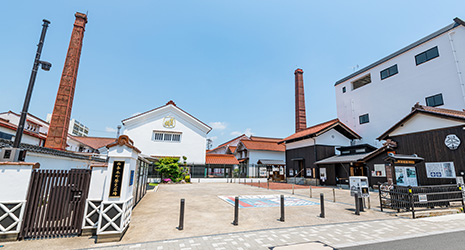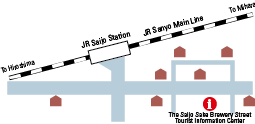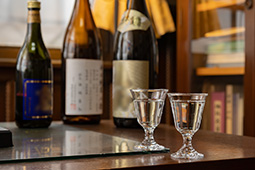April 2023
- English
- 日本語
Hiroshima’s Sake Capital: Saijo Sake Brewery Street

Townscape of Saijo Sake Brewery Street, Higashihiroshima City, Hiroshima Prefecture 
Ishii Eitaro, President of the Saijo Sake Brewers Association and CEO of Kirei Sake Brewery

Map showing JR Saijo Station and the Saijo Sake Brewery Street 
A building with a red tiled roof and a brick chimney and “namako walls” 
A building with a red tiled roof and a brick chimney with the brewery’s name written in white letters 
Sake bottles and glasses in the office of Ishii Eitaro

Saijo in Higashihiroshima City, Hiroshima Prefecture, is known as a town with a tradition of sake brewing that goes back more than 300 years. Saijo Sake Brewery Street, which retains much of its original appearance, is lined with sake breweries that give visitors the opportunity to learn about and taste the many different types of Saijo sake.

Saijo in Higashihiroshima City, Hiroshima Prefecture, along with Fushimi in Kyoto Prefecture and Nada in Hyogo Prefecture, is one of Japan’s big sake brewing areas. Saijo can be reached by train from Hiroshima Station on the JR Sanyo Main Line in less than 40 minutes. Seven sake breweries are to be found on Saijo Sake Brewery Street, which is right in front of JR Saijo Station. The sake breweries have white walls or “namako walls”* and red tiled roofs, those roofs bearing a line of brick chimneys that show the brand names. Saijo flourished as a post town on the Saigoku Highway,** one of the main roads of the Edo period (early 17th to mid-late 19th century), and Saijo Sake Brewery Street retains much of its appearance from that time. In 2017, it was selected as a cultural heritage site by the National Committee (Japan) of the International Council on Monuments and Sites (ICOMOS).
Many tourists enjoy walking down the street and visiting the sake breweries one by one as they take in the old-time atmosphere.
Regarding sake brewing in Saijo, Ishii Eitaro, President of the Saijo Sake Brewers Association and CEO of Kirei Sake Brewery, explains, “Saijo, located in a basin at an altitude of 250 to 300 meters, has a climate with large differences in temperature and is blessed with excellent water, making it an ideal place for sake brewing. That’s why sake brewing in this area began more than 300 years ago.”

Sake is made from water and rice, and “in Saijo, we brew sake using underground water from nearby Mt. Ryuo (elevation about 575 meters). This water is medium-hard water that contains just the right amount of minerals, has a strong ability to grow yeast, and lets fermentation proceed smoothly, making it an ideal sake brewing water. As for the rice, we use 100% high-quality rice from Hiroshima Prefecture. From these raw materials, we produce delicate, mellow, and high-grade sake of high purity. Of the three brands that won the first honorary awards at the Zenkoku Shinshu Kanpyokai back in 1917 (an annual event to evaluate sake launched in 1911), two were sake from Saijo, including sake from my brewery. Even today more than 100 years later, Saijo’s sake is winning numerous awards at competitions.”
Each sake brewery in Saijo has a shop and proudly sells a variety of its own sake. Visitors can sample the sake, and some breweries hold tours where the toji (master brewer) guides tourists through the sake brewing process.***

Nishigaki Masahiro, the toji at Kirei, says, “Sake is an alcoholic beverage made using a very complicated process, and good sake is made by taking the time and effort to handle it carefully. The quality of sake varies depending on those who make it, and Saijo’s sake are also full of individuality, so I think it’s good to go around breweries and sample their products to find sake you like. At our sake brewery, we use a traditional method to make dry sake that has an aromatic fragrance, umami, and refreshing throat-feel, and we pursue a quality of sake that makes you want to drink it again.”
The various breweries offer not only sake, but also original products like sweets and gelato made from sake lees, udon noodles kneaded with sake, soap containing sake lees, and canvas bags with the brewery’s logo. In addition to restaurants and cafés directly managed by the breweries, along Sake Brewery Street or the little side streets there are bakeries that use the local sake breweries’ brewing water and sake lees, as well as cafés in old Japanese-style houses that serve dishes using sake, so there are various ways you can enjoy sake.

Another local specialty is bishu nabe (literally, beautiful sake hot pot), which is a hearty hot pot dish featuring plenty of seasonal vegetables and pork, cooked only with sake, salt, and pepper. It is served at restaurants along Saijo Sake Brewery Street and other places nearby, and it is recommended that you eat it with Saijo sake.
Why not take a short trip from Hiroshima Station and visit Saijo Sake Brewery Street to enjoy the charm of sake?

* A traditional finish for walls in Japan in which the wall is covered in flat tiles to protect plaster from damage caused by rainwater. The plaster strips between the tiles are said to resemble sea cucumbers (namako).
** Once the main road for travel in Western Japan and the basis for the current national highway Route 2.
*** Tours may cost a fee and require prior application, so please check with the brewery in advance (as of April 2023).

